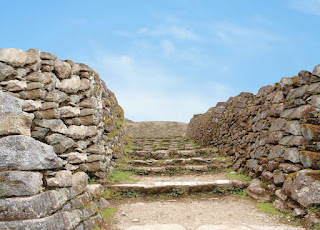He then tells us that he taught his “people to build buildings, and to work in all manner of wood, and of iron, and of copper, and of brass, and of steel, and of gold, and of silver, and of precious ores, which were in great abundance” (2 Nephi 5:15). He also caused his “people to be industrious, and to labor with their hands” (2 Nephi 5:17). This is also the time that the Lord cursed “a sore cursing, because of their iniquity” to come upon the Lamanites, and “because of their cursing which was upon them they did become an idle people, full of mischief and subtlety, and did seek in the wilderness for beasts of prey” (2 Nephi 5:24).
Of Nephi’s efforts to defend his people, his brother Jacob wrote: “he having been a great protector for them, having wielded the sword of Laban in their defense, and having labored in all his days for their welfare” (Jacob 1:10), shows that the Lamanites, during Nephi’s time, were battling and attacking the Nephites. Jacob’s son, wrote of the Lamanites: “their hatred was fixed, and they were led by their evil nature that they became wild, and ferocious, and a bloodthirsty people, full of idolatry and filthiness; feeding upon beasts of prey; dwelling in tents, and wandering about in the wilderness with a short skin girdle about their loins and their heads shaven; and their skill was in the bow, and in the cimeter, and the ax. And many of them did eat nothing save it was raw meat; and they were continually seeking to destroy us” (Enos 1:20). We also learn from Jacob’s son, that he “saw wars between the Nephites and Lamanites in the course of my days” (Enos 1:24).
In the next generation, the Lamanites had deteriorated even further, and “came many times against the Nephites to battle” (Jarom 1:7). Thus, we see that Nephi, when making swords for his people and their defense, had a good idea what was going to happen between his people and those of his brothers. The fact that he made weapons for his people, taught them to build buildings, and labored diligently in their defense, suggests that one of the things Nephi would have done was to build some type of early warning defensive outpost close to and south of their settlement (city of Nephi), yet far enough away to aid them through fast runners to know that the Lamanites were approaching up the narrow valley toward them. This outpost would have been located in an area where the road or route into Cuzco would have been restricted, and any approaching force would have been readily visible.
Map of Cuzco area and the Wanakawri Fortress that guarded the entrance
into the Huatanay Valley
This ancient city, which Pizarro and his small band of conquistadors sacked in 1533 AD, held some 200,000 people at the time, part of a kingdom believed to have been 12 million strong. The original city had narrow and frequently stepped streets, often narrow running between buildings constructed out of stones that were cut in irregular shapes and fitted with unbelievable precision without mortar. The following year, Pizarro formally established the municipal of government at Cuzco, but a year after moved the capital to the coastal site of Lima, whereupon Cuzco rapidly dwindled in power and importance.
La Montaña Wanakauri o Huanacaure, “the Mountain of Wanakauri or Huanacure” is located three miles to the south of Cuzco, and was a small fortress in the mountain guarding the entrance to the two great valleys—Cuzco and Urubamba, the heart of ancient Peruvian center and later Inca empire. The road from Wanakauri joined the main road that is considered one of the greatest engineering feats in the Americas, leading southward out of Cuzco toward Huarcapay and the Lucre District before turning further south toward Andahuaylillas and known today as 3S (Ecuador highway 3 south).
The ancient location of Wanakauri or Huanacaure, a site full of
history. It sits at an altitude of 13,386 feet, and is about three miles south
of the city of Cuzco, behind the Condoroma, Araja, Huillcaray and Quispiquilla
hills and east of Cerro Anawarque. Next to the ancient temple of Qorikancha
(Coricancha) in the center of Cuzco, it was the most important shrine in the
Cuzco area
The ancient road south of Cuzco,
stepped up over the hill, showing the containment walls on each side
South of there, where the road heads into Cajamarca, it was dauntingly steep, and its seemingly endless stepped terraced-stone expanse was a wide-granite thoroughfare spilling continually down from the Peruvian Andes into the flat valley of Cajamarca—the most important ancient city in north central Peru. This was the route the ancient conquistadors took southward to eventually enter Cuzco—what must have been an astounding experience for these European invaders of the early 16th century. Along this roadway they walked much of the way to Cuzco, since their horses suffered terribly from the sharp edges of the roadway’s stepped inclines. Most of the Spaniards were impoverished farmers from the region of Extremadura, and must have been awed when they rounded the corner, and entered the vast plaza at the heart of an empire, surrounded with monumental palaces and temples, everything glittering with gold leaf and brilliant hanging textiles—commemorating a kingdom more fabulous than Seville and as accomplished as Rome.
The ancient road running along the Vilcanota River through the narrow
valley south of Cuzco where it enters the Huatanay Valley. Note the narrow area
of approach and how easily it could be observed and defended
(See the next post, “Fortress Guarding Cuzco or the City of Nephi – Part II,” for additional information on the outpost that guarded the entrance into Cuzco, or the city of Nephi)









No comments:
Post a Comment